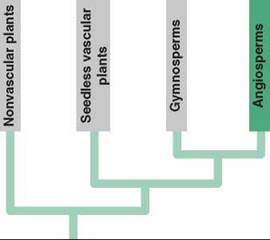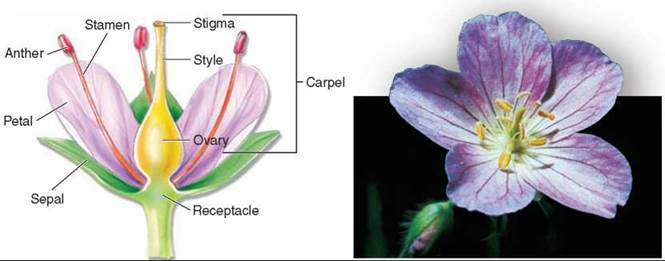THE LIVING WORLD
Unit Seven. Plant Life
32. Evolution of Plants

Angiosperms are plants in which the ovule is completely enclosed by sporophyte tissue when it is fertilized. Ninety percent of all living plants are angiosperms, about 250,000 species, including many trees, shrubs, herbs, grasses, vegetables, and grains—in short, nearly all of the plants that we see every day. Virtually all of our food is derived, directly or indirectly, from angiosperms. In fact, more than half of the calories we consume come from just three species: rice, corn, and wheat.
In a very real sense, the remarkable evolutionary success of the angiosperms is the apparent culmination of the plant kingdom’s adaptation to life on land, although plants continue to evolve. Angiosperms successfully meet the last difficult challenge posed by terrestrial living: the inherent conflict between the need to obtain nutrients (solved by roots, which anchor the plant to one place) and the need to find mates (solved by accessing plants of the same species). This challenge has never really been overcome by gymnosperms, whose pollen grains are carried passively by the wind on the chance that they might by luck encounter a female cone. Think about how inefficient this is! Angiosperms are able to deliver their pollen directly, as if in an addressed envelope, from one individual of a species to another. How? By inducing insects and other animals to carry it for them! The tool that makes this animal-dictated pollination possible, the great advance of the angiosperms, is the flower. While some very successful later-evolving angiosperms like grasses have reverted to wind pollination, the directed pollination of flowering plants has led to phenomenal evolutionary success.
The Flower
Flowers are the reproductive organs of angiosperm plants. A flower is a sophisticated pollination machine. It employs bright colors to attract the attention of insects (or birds or small mammals), nectar to induce the insect to enter the flower, and structures that coat the insect with pollen grains while it is visiting. Then, when the insect visits another flower, it carries the pollen with it into that flower.
The basic structure of a flower consists of four concentric circles, or whorls, connected to a base called the receptacle:
1. The outermost whorl, called the sepals of the flower, typically serves to protect the flower from physical damage. These, the green leaflike structures in the diagram above, are in effect modified leaves that protect the flower while it is a bud. The sepals can be seen surrounding the flower bud to the lower left of the flower in the photo below.
2. The second whorl, called the petals of the flower, serves to attract specific pollinators. Petals have particular pigments, often vividly colored like the light purple color in the flower diagramed below.
3. The third whorl, called the stamens of the flower, contains the “male” parts that produce the pollen grains. Stamens are the slender, threadlike filaments in the diagram with a swollen anther at the tip containing pollen.
4. The fourth and innermost whorl, called the carpel of the flower, contains the “female” parts that produce eggs. The carpel is the vase-shaped structure in the diagramed flower. The carpel is sporophyte tissue that completely encases the ovules within which the egg cell develops. The ovules occur in the bulging lower portion of the carpel, called the ovary; usually there is a slender stalk rising from the ovary called the style, with a sticky tip called a stigma, which receives pollen. When the flower is pollinated, a pollen tube grows down from the pollen grain on the stigma through the style to the ovary to fertilize the egg.

Key Learning Outcome 32.8. Angiosperms are seed plants in which the ovule is completely enclosed by diploid tissue at pollination and that use flowers to attract pollinators.